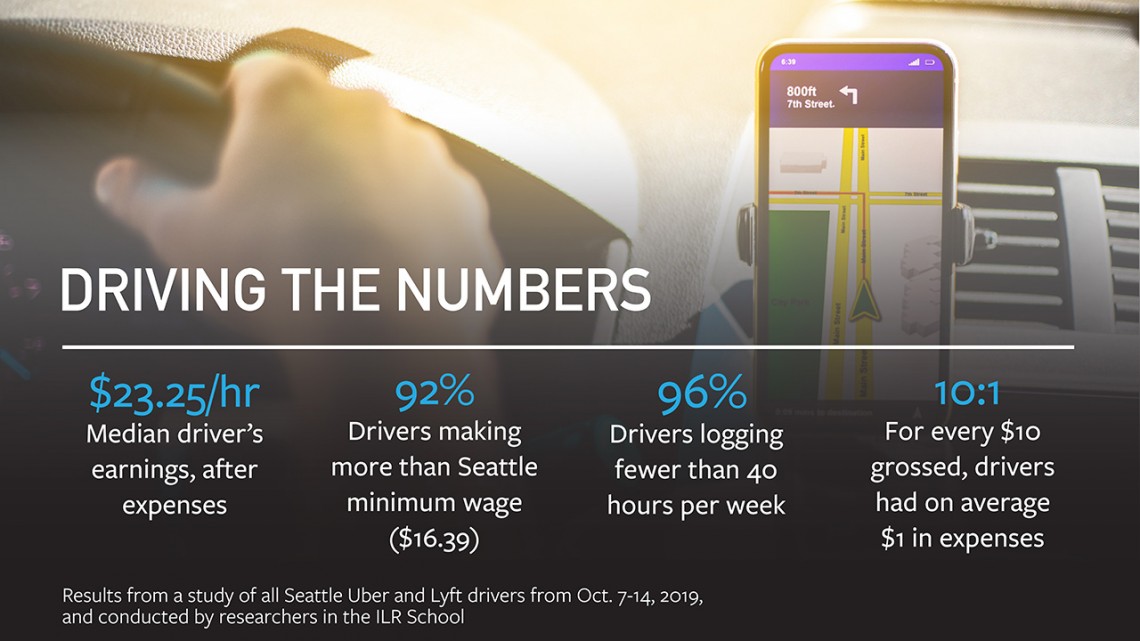
Seattle ride-share drivers earn city average, ILR study finds
By Mary Catt
Contrary to anecdotal evidence, the vast majority of Uber and Lyft drivers in Seattle earn more than the average taxi driver, and their hourly earnings are on par with the general workforce of that city, according to an Institute for Workplace Studies report commissioned by the two major ride-share platforms.
The research team combined data of all Uber and Lyft drivers in Seattle – marking the first time driver-level microdata from the two platforms has been merged. Findings were released July 6 in a white paper posted at DigitalCommons@ILR.
The study was led by Louis Hyman, the Maurice and Hinda Neufeld Founders Professor in Industrial and Labor Relations, and director of the Institute for Workplace Studies (IWS), in Cornell’s ILR School.
“As more and more American workers find themselves combining multiple income streams, this study is an attempt to understand how that combination of platforms affects workers’ earnings,” Hyman said.
As Seattle officials considered policy around ride-share businesses, Uber and Lyft approached the IWS about doing an independent analysis of drivers’ time and earnings, Hyman said.
Working with the Cornell Restricted Access Data Center, researchers were able to guarantee driver and company data security. Neither Lyft nor Uber saw the merged data, only the completed analysis. Driver identities were completely anonymous.
Among the findings:
- The median driver earned, after expenses, $23.25 per hour;
- Nine in 10 drivers made more per hour than the average Seattle taxi driver ($16.81), even after expenses;
- 92% of drivers make more than the Seattle minimum wage ($16.39), even after deducting expenses;
- The median full-time platform driver earned, after costs and on an annualized basis, $49,296 – higher than taxi drivers ($34,957) and close to the Seattle median for all occupations ($52,945);
- 96% of drivers drove fewer than 40 hours per week, and 31% drove fewer than five hours; and
- For every $10 drivers grossed, they had on average $1 in expenses.
“From anecdotes and surveys, we had the impression that the majority of drivers were underpaid and full time,” Hyman said. “The vast majority of Seattle drivers had a different experience.”
The study found that the vast majority of drivers were driving as a side job, not full time, and their hourly earnings were about average for Seattle.
The study relied on a merged dataset that allowed the researchers, for the first time, to eliminate overlapping driver wait time.
“Imagine a driver with both the Lyft and the Uber apps on, who waits 10 minutes for a ride,” Hyman said. “Previously released aggregated statistics would show that driver waiting for 20 minutes, not 10. All previous calculations that took into account driver wait time would inevitably calculate excessive wait times.”
Deduplicating wait time reduced median wait time by 13%. The study found that once the app is on and a driver is actively seeking rides, the typical driver spends about 28% of his or her time waiting for a ride request.
“Good policy relies on good analysis,” Hyman said. “These results are not from a survey or from aggregated statistics, but from every single platform driver in Seattle, direct from the administrative records. We think that policymakers, as they move forward, can rely on this study to help understand an important part of the changing nature of work in Seattle.”
Other contributors to the study included Erica L. Groshen, an ILR senior labor economics adviser and former commissioner of the U.S. Bureau of Labor Statistics; Adam Seth Litwin, associate professor of labor relations, law and history at the ILR School; Martin T. Wells, the Charles A. Alexander Professor of Statistical Sciences, ILR’s director of research, and chair of Cornell’s Department of Statistics and Data Science; Kwelina Thompson, doctoral student in the field of history; and Kyrylo Chernyshov ’20 (statistics and computer science).
The ILR School conducted the study through the Office of Sponsored Research at Cornell, which oversees grant-funded research. Uber and Lyft covered research costs; faculty members were not compensated.
Mary Catt is the ILR School’s communications director.
Media Contact
Get Cornell news delivered right to your inbox.
Subscribe
